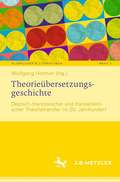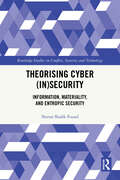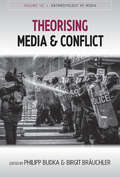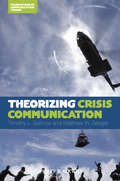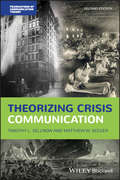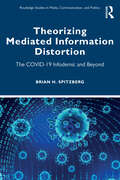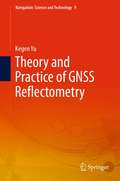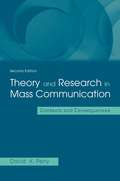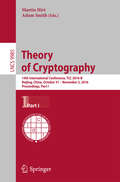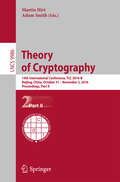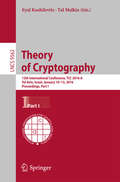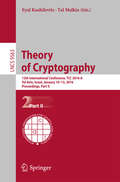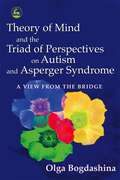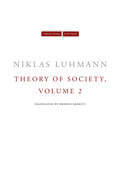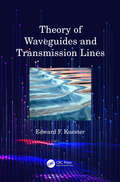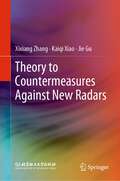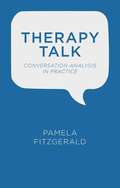- Table View
- List View
Theorieübersetzungsgeschichte: Deutsch-französischer und transatlantischer Theorietransfer im 20. Jahrhundert (Globalisierte Literaturen. Theorie und Geschichte transnationaler Buchkultur / Globalized Literatures. Theory and History of Transnational Book Culture #2)
by Wolfgang HottnerIm Zuge der Historisierung von Theorie ist die Rolle von Übersetzungen sowie die vermittelnde Rolle der Übersetzer*innen bisher nur am Rande berücksichtigt worden. Doch für die Rezeption, Internationalisierung und Kanonisierung von Theorie spielen diese eine entscheidende Rolle, weshalb sich dieser Band der Geschichte der Theorie in Hinblick auf ihre Übersetzungen nähert. Die Brisanz, die Theorie in Deutschland, Frankreich und den USA von Anfang der 1960er bis Ende der 1990er Jahre entfalten konnte, verdankt sich nicht nur der Mobilität ihrer Protagonist*innen, sondern auch der Verfügbarkeit von Übersetzungen, in denen Theorie von einer Sprache in die andere übergeht, dabei ‚anschlussfähig‘ wird. Theorieübersetzungsgeschichte rückt die Arbeit von Übersetzer*innen in den Blick, die wechselseitige Beziehung von Übersetzungstheorie und poststrukturalistisch-dekonstruktivem Denken sowie ein spezifisches Verständnis von Übersetzung, das mit dem Anspruch verbunden ist, im Verlauf gegenwärtiger Debatten zu intervenieren.
Theorising Culture: A Chinese Perspective (Palgrave Studies in Teaching and Learning Chinese)
by Jinghe HanThis book seeks for an alternative perspective in analysing cultural phenomena to supplement the norm of Western dominant theorising and conceptualisation. It engages notions and concepts of culture developed by Chinese cultural theorists when addressing Chinese teachers’ cross-cultural experiences in Australian school settings. This alternative approach acknowledges the fact that the generation and development of cultural theories is contextually based. Through the reciprocated theory-data examination, it enables the arguments: Chinese culture is rooted in its written language (hanzi) which makes culture inseparable from language teaching; the core of the culture is linked back to, streamlined with and continues from China’s elongated history; this core has been consistently influential on these teachers’ practices and the observable cultural shift in them could be non-genuine mimicry for survival. Document analysis witnesses the current political push for the culture’s stability and continuity through the national education system across sectors. This book provides background information for teachers with cultural backgrounds different from their students’, and draws on a bank of practice-based evidence to suggest ways to enhance teacher-student relationships in cross-cultural settings.
Theorising Cyber: Information, Materiality, and Entropic Security (Routledge Studies in Conflict, Security and Technology)
by Noran Shafik FouadThis book argues that cybersecurity’s informational ontology offers empirical challenges, and introduces a new interdisciplinary theoretical and conceptual framework of ‘entropic security’.Cyber-attacks have been growing exponentially in number and sophistication; ranging from those conducted by non-state actors to state-backed cyber-attacks. Accordingly, cybersecurity now constitutes an integral part of public, private, and academic discourses on contemporary (in)security. Yet, because its emergence as a novel security field occurred after many long-established frameworks had already been developed, cybersecurity has been repeatedly scrutinised for its compatibility with conventional security theories, concepts, and understandings, particularly with that of military security. This book, however, argues that cybersecurity differs profoundly from many other security sectors because of the ontological nature of ‘information’ that sits at the heart of this field. Through this new framework, the book investigates three key empirical challenges in cybersecurity that are co-produced by its informational ontology: (1) the disordered nature of cybersecurity and its tendency towards increasing insecurity as a manifestation of the intrinsic uncertainties in information systems; (2) the unpredictable and unintended consequences resulting from autonomous cyber-attacks that challenge human control of cybersecurity environments; and (3) the persistent harms engendered by ‘mundane’ cyber threats that do not fit within conventional understandings of existentiality in security theories. Through a detailed analysis of cybersecurity discourses and practices in the USA (2003-present), the book goes on to show how these complex cybersecurity challenges are better analysed and theorised through the new information-theoretic notion of ‘entropic security’.This book will be of much interest to students of cyber-security, critical security studies, science and technology studies and International Relations in general.
Theorising Media and Conflict (Anthropology of Media #10)
by Birgit Bräuchler Philipp BudkaTheorising Media and Conflict brings together anthropologists as well as media and communication scholars to collectively address the elusive and complex relationship between media and conflict. Through epistemological and methodological reflections and the analyses of various case studies from around the globe, this volume provides evidence for the co-constitutiveness of media and conflict and contributes to their consolidation as a distinct area of scholarship. Practitioners, policymakers, students and scholars who wish to understand the lived realities and dynamics of contemporary conflicts will find this book invaluable.
Theorizing Crisis Communication
by Matthew W. Seeger Timothy L. SellnowTheorizing Crisis Communication presents a comprehensive review and critique of the broad range of theoretical frameworks designed to explain the role of communication in the development, management, and consequences of natural and man-made crises.Brings together the variety of theoretical approaches emerging in the study of crisis communication into one volume for the first time.Summarizes theories from such diverse perspectives as rhetoric, risk management, ethics, mass communication, social media, emergency response, crisis outcomes, and warning systems, while presenting clear examples of how the theory is applied in crisis communication researchPresents theoretical frameworks generated by research from many disciplines including sociology, psychology, applied anthropology, public health, public relations, political science, organizational studies, and criminal justiceAn essential tool for a comprehensive understanding of the onset, management, response, resolution, and ultimate meaning of these devastating world events
Theorizing Crisis Communication (Foundations of Communication Theory Series)
by Matthew W. Seeger Timothy L. SellnowExplore the major theories within crisis communication, fully revised and updated Theorizing Crisis Communication provides a comprehensive and state-of-the-art review of both current and emerging theoretical frameworks designed to explain the development, management, and consequences of natural and human-caused crises. A critique of the many theoretical approaches of crisis communication, this volume provides readers with an in-depth understanding of the management, response, resolution, and significance of failures in corporate responsibility, as well as destructive global events such as pandemics, earthquakes, hurricanes, tsunamis, chemical spills, and terrorist attacks. This second edition contains new theories from related subfields and updated examples, references, and case examples. New chapters discuss metatheoretical considerations and theoretical advancements in the study of social media. Throughout the text, the authors highlight similarities, patterns, and relationships across different crisis types and offer insight into the application of theory in the real world. Integrating work from organizational studies, social sciences, public relations, and public health, this book: Covers a broad range of crisis communication theories, including those relevant to emergency response, risk management, ethics, resilience and crisis warning, development, and outcomes Presents theoretical frameworks based on research disciplines including sociology, psychology, applied anthropology, and criminal justice Provides clear and compelling examples of application of theory in contexts such as rhetoric, mass communication, social media, and warning systems Offers a systematic and accessible presentation of topics by explaining each theory, describing its applications, and discussing its advantages and drawbacks Theorizing Crisis Communication, Second Edition, is the perfect textbook for advanced undergraduate and graduate students of crisis and risk communication, and an importance reference for scholars, researchers, and practitioners in fields including crisis communication, emergency management, disaster studies, sociology, psychology, and anthropology.
Theorizing Digital Rhetoric
by Aaron Hess Amber DavissonTheorizing Digital Rhetoric takes up the intersection of rhetorical theory and digital technology to explore the ways in which rhetoric is challenged by new technologies and how rhetorical theory can illuminate discursive expression in digital contexts. The volume combines complex rhetorical theory with personal anecdotes about the use of technologies to create a larger philosophical and rhetorical account of how theorists approach the examinations of new and future digital technologies. This collection of essays emphasizes the ways that digital technology intrudes upon rhetorical theory and how readers can be everyday rhetorical critics within an era of ever-increasing use of digital technology. Each chapter effectively blends theorizing between rhetoric and digital technology, informing readers of the potentiality between the two ideas. The theoretical perspectives informed by digital media studies, rhetorical theory, and personal/professional use provide a robust accounting of digital rhetoric that is timely, personable, and useful.
Theorizing Mediated Information Distortion: The COVID-19 Infodemic and Beyond (Routledge Studies in Media, Communication, and Politics)
by Brian H. SpitzbergThis book explores the phenomenon of distortion of information through media via the lens of the COVID-19 pandemic, and the ways in which relevant information distortion and virality have occurred in regard to the disease and its risks. Positing that the interrelated processes of misinformation, disinformation, fake news and conspiracy theories are related forms of distortion of information through media (DIM) and can only be understood through a multilevel theoretical model that incorporates message-based, individual difference, social network-based, societal and geotechnical factors, Brian H. Spitzberg develops an integrative, well-argued, and well-evidenced framework within which these issues can and should be addressed. This book offers a model for further research across such disciplines as communication, journalism/media studies, political science, sociology, cognitive psychology, social psychology, evolutionary psychology, public health, big data analytics, social network analytics, computational linguistics and geographic information sciences, and will interest researchers and students in those areas.
Theorizing Pedagogical Interaction: Insights from Conversation Analysis (Routledge Research in Education)
by Hansun Zhang WaringPedagogical interaction can be observed through many different landscapes, such as the graduate seminar, the writing skills center, the after-school literacy program, adult ESL classrooms, and post-observation conferences. By viewing these settings through the lens of conversation analysis, this volume lays the groundwork for three principles of pedagogical interaction: competence, complexity, and contingency. The author explores these principles and how they inform what makes a good teacher, how people learn, and why certain pedagogical encounters are more enlightening than others. Drawn from the author’s original research in various pedagogical settings, this volume collects empirical insights from conversation analysis and contributes to theory building. Theorizing Pedagogical Interaction will appeal to students and scholars in applied linguistics, educational linguistics, and communication studies who are interested in the discourse of teaching and learning.
Theory and Best Practices in Science Communication Training (Routledge Studies in Environmental Communication and Media)
by Todd NewmanThis edited volume reports on the growing body of research in science communication training, and identifies best practices for communication training programs around the world. Theory and Best Practices in Science Communication Training provides a critical overview of the emerging field of by analyzing the role of communication training in supporting scientists’ communication and engagement goals, including scientists’ motivations to engage in training, the design of training programs, methods for evaluation, and frameworks to support the role of communication training in helping scientists reach their communication and engagement goals. This volume reflects the growth of the field and provides direction for developing future researcher-practitioner collaborations. With contributions from researchers and practitioners from around the world, this book will be of great interest to students, scholars and, professionals within this emerging field.
Theory and Design of Digital Communication Systems
by Tri T. HaHa (electrical and computer engineering, Naval Postgraduate School, Monterey, California) presents a textbook with material for two one-semester courses in digital communications. The first is for senior undergraduate students who have completed an introductory communications course that is heavy on analog communications. The second course is for graduate students who have a firm background in random variables and processes. The practical material might be helpful as well for practitioners and professionals in digital communications, he says, especially in commercial and military applications. His topics include deterministic and random signal analysis, information theory and channel coding, modulation and demodulation, intersymbol interference and equalization, and fading channels. Annotation ©2011 Book News, Inc. , Portland, OR (booknews. com)
Theory and Design of Terabit Optical Fiber Transmission Systems
by Stefano BottacchiThis comprehensive, modular treatment of the challenging issues involved in very high-speed optical transmission systems contains all the theory and practical design criteria required to optimise transmission system design. Each chapter covers the theoretical modelling of a given system; chapters are well supported by real-world worked examples and accompanied by MATLAB code and receiver design examples. Critical analysis and comparison of engineering solutions is presented, to make clear the principles underlying system performance optimisation, and a broad range of transmission systems is discussed, including the status and performance demands of the Terabit systems now entering the next generation market. Blending theoretical and practical considerations for high-speed fibre optic systems design, this is an indispensable reference for all forward-looking professionals and researchers in optical communications.
Theory and Practice of GNSS Reflectometry (Navigation: Science and Technology #9)
by Kegen YuThis is the first authored English book completely focused on global navigation satellite system reflectometry (GNSS-R). It consists of two main parts: the fundamental theory; and major applications, which include ocean altimetry, sea surface wind speed retrieval, snow depth measurement, soil moisture measurement, tsunami detection and sea ice detection. Striking a healthy balance between theory and practice, and featuring in-depth studies and extensive experimental results, the book introduces beginners to the fundamentals, while preparing experienced researchers to pursue advanced investigations and applications in GNSS-R.
Theory and Practice of Wireless Sensor Networks: Cover, Sense, and Inform (Studies in Systems, Decision and Control #214)
by Habib M. AmmariThis book aims at developing a reader’s thorough understanding of the challenges and opportunities of two categories of networks, namely k-covered wireless sensor networks and k-barrier covered wireless sensor networks. It presents a variety of theoretical studies based on percolation theory, convexity theory, and applied computational geometry, as well as the algorithms and protocols that are essential to their design, analysis, and development. Particularly, this book focuses on the cover, sense, and inform (CSI) paradigm with a goal to build a unified framework, where connected k-coverage (or k-barrier coverage), sensor scheduling, and geographic data forwarding, gathering, and delivery are jointly considered. It provides the interested reader with a fine study of the above networks, which can be covered in introductory and advanced courses on wireless sensor networks. This book is useful to senior undergraduate and graduate students in computer science, computer engineering, electrical engineering, information science, information technology, mathematics, and any related discipline. Also, it is of interest to computer scientists, researchers, and practitioners in academia and industry with interest in these two networks from their deployment until data gathering and delivery.
Theory and Research in Mass Communication: Contexts and Consequences (Routledge Communication Ser.)
by David K. PerryThis updated edition presents a civic journalism treatment of the field of mass communication research. The sine qua non of the civic journalism movement seems to center around an implicit assumption that the human mind is an evolved part in the natural world, not a detached spectator as much traditional philosophy assumes. Thus, it has attempted to encourage journalists and members of their audiences to participate actively in civic life. Applying the same idea to mass communication academics, this book focuses on the empirical consequences of their work, especially its possible impact on human life. It argues that researchers need to connect with the broader communities in which they live and considers the impact of media research on society. Features of the second edition include: *detailed update of research evidence concerning the media violence issue; *additional material concerning media ownership structures and their possible relationship to media content and effects; *new material focusing on the impact of tobacco and alcohol advertising; *updated and expanded section concerning the history of media studies; and *an expanded discussion of philosophical issues pertaining to theory construction. This book is intended for graduate and advanced undergraduate students studying mass communication theory and related subjects, such as communication theory, media effects, media literacy, and media and society.
Theory of Cryptography
by Adam Smith Martin HirtThe two-volume set LNCS 9985 and LNCS 9986 constitutes the refereed proceedings of the 14th International Conference on Theory of Cryptography, TCC 2016-B, held in Beijing, China, in November 2016. The total of 45 revised full papers presented in the proceedings were carefully reviewed and selected from 113 submissions. The papers were organized in topical sections named: TCC test-of-time award; foundations; unconditional security; foundations of multi-party protocols; round complexity and efficiency of multi-party computation; differential privacy; delegation and IP; public-key encryption; obfuscation and multilinear maps; attribute-based encryption; functional encryption; secret sharing; new models.
Theory of Cryptography
by Adam Smith Martin HirtThe two-volume set LNCS 9985 and LNCS 9986 constitutes the refereed proceedings of the 14th International Conference on Theory of Cryptography, TCC 2016-B, held in Beijing, China, in November 2016. The total of 45 revised full papers presented in the proceedings were carefully reviewed and selected from 113 submissions. The papers were organized in topical sections named: TCC test-of-time award; foundations; unconditional security; foundations of multi-party protocols; round complexity and efficiency of multi-party computation; differential privacy; delegation and IP; public-key encryption; obfuscation and multilinear maps; attribute-based encryption; functional encryption; secret sharing; new models.
Theory of Cryptography
by Tal Malkin Eyal KushilevitzThe two-volume set LNCS 9562 and LNCS 9563 constitutes the refereed proceedings of the 13th International Conference on Theory of Cryptography, TCC 2016, held in Tel Aviv, Israel, in January 2016. The 45 revised full papers presented were carefully reviewed and selected from 112 submissions. The papers are organized in topical sections on obfuscation, differential privacy, LWR and LPN, public key encryption, signatures, and VRF, complexity of cryptographic primitives, multiparty computation, zero knowledge and PCP, oblivious RAM, ABE and IBE, and codes and interactive proofs. The volume also includes an invited talk on cryptographic assumptions.
Theory of Cryptography
by Tal Malkin Eyal KushilevitzThe two-volume set LNCS 9562 and LNCS 9563 constitutes the refereed proceedings of the 13th International Conference on Theory of Cryptography, TCC 2016, held in Tel Aviv, Israel, in January 2016. The 45 revised full papers presented were carefully reviewed and selected from 112 submissions. The papers are organized in topical sections on obfuscation, differential privacy, LWR and LPN, public key encryption, signatures, and VRF, complexity of cryptographic primitives, multiparty computation, zero knowledge and PCP, oblivious RAM, ABE and IBE, and codes and interactive proofs. The volume also includes an invited talk on cryptographic assumptions.
Theory of Mind and the Triad of Perspectives on Autism and Asperger Syndrome: A View from the Bridge
by Olga BogdashinaInspired by the often uncomfortable interplay between autistic individuals, parents and professionals in understanding autistic spectrum conditions, Olga Bogdashina uses the concept of Theory of Mind (ToM) to consider these groups' different (and often conflicting) perspectives. ToM is the ability to imagine and make judgements about what others feel and think; its absence in autistic individuals is called 'mindblindness'. This book addresses the 'mindblindness' of people united in their interest in autism but divided by their different angles and perspectives. Divided into four parts, the book first defines autism, then the views of the three main groups working with it - autistic individuals, parents and professionals - under the headings of classifications, diagnosis, causes, development, theories and treatment. By comparing and reconciling the different perspectives in this way, the book helps each group to understand and predict each other's responses and behaviours. This enlightening and innovative book offers a unique way of 'stepping in each other's shoes' and is a valuable resource for all people living or working with autism.
Theory of Quantum Computation, Communication, and Cryptography
by Dave Bacon Miguel Martin-Delgado Martin RoettelerThis book constitutes the thoroughly refereed post-conference proceedings of the 6th Conference on Theory of Quantum Computation, Communication, and Cryptography, TQC 2011, held in Madrid, Spain, in May 2011. The 14 revised papers presented were carefully selected from numerous submissions. The papers present new and original research and cover a large range of topics in quantum computation, communication and cryptography, a new and interdisciplinary field at the intersection of computer science, information theory and quantum mechanics.
Theory of Society, Volume 2
by Niklas Luhmann translated by Rhodes BarrettThis second volume of Niklas Luhmanns two-part final work was first published in German in 1997. The culmination of his thirty-year theoretical project to reconceptualize sociology, it offers a comprehensive description of modern society. Beginning with an account of the fluidity of meaning and the accordingly high improbability of successful communication, Luhmann analyzes a range of communicative media, including language, writing, the printing press, and electronic media, as well as "success media," such as money, power, truth, and love, all of which structure this fluidity and make communication possible. The book asks what gives rise to functionally differentiated social systems, how they evolve, and how social movements, organizations, and patterns of interaction emerge. The advent of the computer and its networks, which triggered potentially far-reaching processes of restructuring, receives particular attention. A concluding chapter on the semantics of modern societys self-description bids farewell to the outdated theoretical approaches of "old Europe"--that is, to ontological, holistic, ethical, and critical interpretations of society--and argues that concepts such as "the nation," "the subject," and "postmodernity" are vastly overrated. In their stead, "society"--long considered a suspicious term by sociologists, one open to all kinds of reification--is defined in purely operational terms. It is the always uncertain answer to the question of what comes next in all areas of communication.
Theory of Waveguides and Transmission Lines
by Edward F. KuesterThis book covers the principles of operation of electromagnetic waveguides and transmission lines. The approach is divided between mathematical descriptions of basic behaviors and treatment of specific types of waveguide structures. Classical (distributed-network) transmission lines, their basic properties, their connection to lumped-element networks, and the distortion of pulses are discussed followed by a full field analysis of waveguide modes. Modes of specific kinds of waveguides - traditional hollow metallic waveguides, dielectric (including optical) waveguides, etc. are discussed. Problems of excitation and scattering of waveguide modes are addressed, followed by discussion of real systems and performance.
Theory to Countermeasures Against New Radars
by Xixiang Zhang Kaiqi Xiao Jie GuThis book introduces readers to a range of jamming principles and techniques for new radars, combining a wealth of theoretical analyses, test data, calculations, and charts. With rapid advances in military radar technology, new types of radar are constantly emerging. Therefore, there is an urgent need to carry out effective research on these new radars and to develop corresponding jamming techniques. The main topics covered include development of radar and radar countermeasures; jamming techniques for synthetic aperture radar; jamming techniques for pulse compression radar; jamming techniques for pulse Doppler radar; general jamming techniques for various radars; analysis and calculation of the effective jamming suppression zone and jamming exposure zone for radars installed on different platforms; jamming techniques for phased array radar; jamming techniques for dual (multiple) static radar; and solutions for high equivalent radiation power, high reception sensitivity, and transceiver isolation in jammer design.
Therapy Talk: Conversation Analysis in Practice
by Pamela E. FitzgeraldTherapy Talk aims to help those who apply 'the talking cure' become better at their jobs by enabling them to understand how their verbal responses may channel the conversation partner into a particular direction, promoting conversation analysis as a useful tool to study and enhance the therapeutic alliance between client and practitioner.
